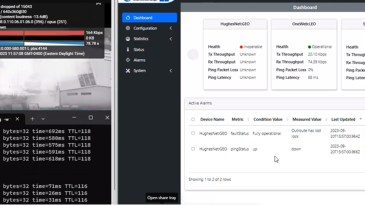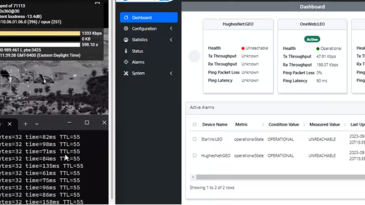Rapid Tiger Event Highlights Hughes Resilient & Flexible SATCOM Capabilities
The Combined Force Space Component Command (CFSCC) hosted its third “Rapid Tiger” advanced training event this year in September 2023. This exercise tests critical command and control operations using current or near-current capabilities and experimentation for the CFSCC, Combined Space Operations Center (CSpcOC) and subordinate organizations.
This iteration of the Rapid Tiger event included members of the Hughes Defense & Government Solutions team to demonstrate resilient communications and Automated Primary Alternate Contingency Emergency (APACE) plans.
The exercise included multiple vignettes based on the Combined Space Operations Center SATCOM Integrated Operations Division (CSpOC SIOD) capabilities requirement to support and maintain satellite communications to the warfighter across the globe despite disruptions to the system in a contested and congested environment.
- Resilient terminal registration & situational awareness with blackout scenario using local PACE plan. This simulated a live communication switch from one commercial satellite communication spacecraft to another. In case of the blackout scenario, the Primary (P) GEO link (upon failure) switched to a Contingent (C) LEO link and then to an Alternate (A) when the 2nd path equipment failed. The switchover times of P to C to A recorded were in seconds. The reverse path was also demonstrated where the failed terminals were brought back online and A to C to P was restored to original state.
- Resilient WAN Link demonstration through brownout conditions. This addressed what actions would need to be taken when the adversary introduces Electromagnetic signal interference to disrupt the communication (brownout and signal degradation). The electronic jamming scenario was simulated and detected by the primary link and immediately switched the contingency to maintain comms link.
- Resilient WAN Link switchover demonstration as orchestrated by the PACE Plan transferred from NMS. Using the PACE configuration defined in the Network Management System (NMS), this scenario demonstrated the ability to switch paths when the primary transport failed, based on a set of predefined policies and thresholds.
Smart Network Edge Enables Resilient Communications
Throughout the demonstration, APACE was achieved through powerful mission planning technology from Hughes that dynamically plans and provides common operations pictures for situational awareness. Using alarm and log management via a Web GUI with role-based access control (RBAC), it has the capability to change capacity, QoS, and various time/space-based resource commitments to improve the speed of change and access to SATCOM resources. New service requests were processed with command-in-the-loop to accommodate new threats in the theatre, and then automatically distributed to terminals managed by Hughes Smart Network Edge (SNE). The SNE is a key enabler for state-of-the-art resilient communications utilizing multiple diverse transports including GEO, MEO, LEO and 5G systems.
As a leader in secure defense communications solutions, this demonstration reinforced our ability to deliver a resilient multi-constellation, multi-orbit, satellite-provider agnostic architecture, using software-defined solutions to improve network resiliency and provide real-time request for channels, performance monitoring, automatic beam switching, fault monitoring and other satellite operations requests.
The Rapid Tiger Exercise highlighted the high Technology Readiness Level (TRL) of Hughes flexible architecture, which can accommodate multiple service providers and manage services across multi-satellite and multi-orbit constellations. Learn more about Hughes capabilities for resilient and secure missions.

